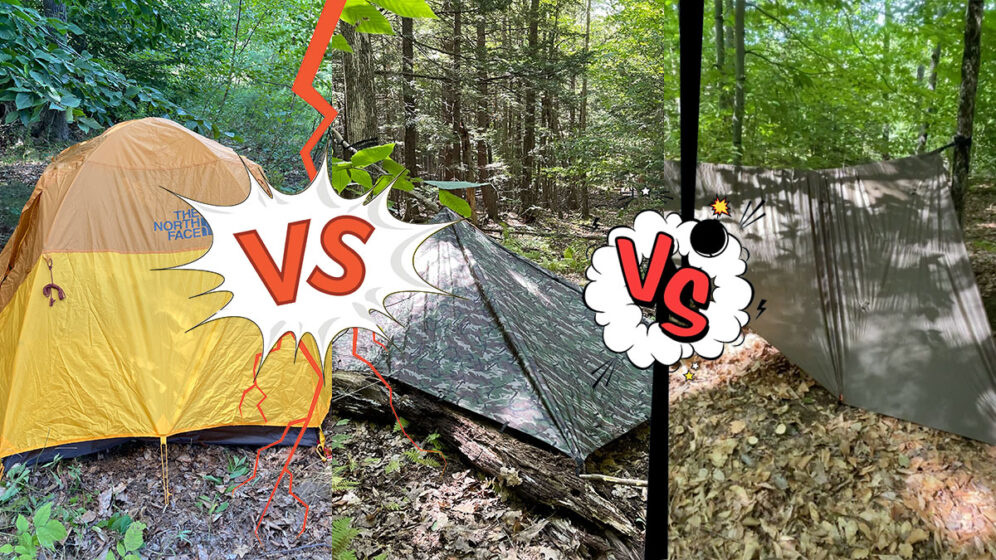
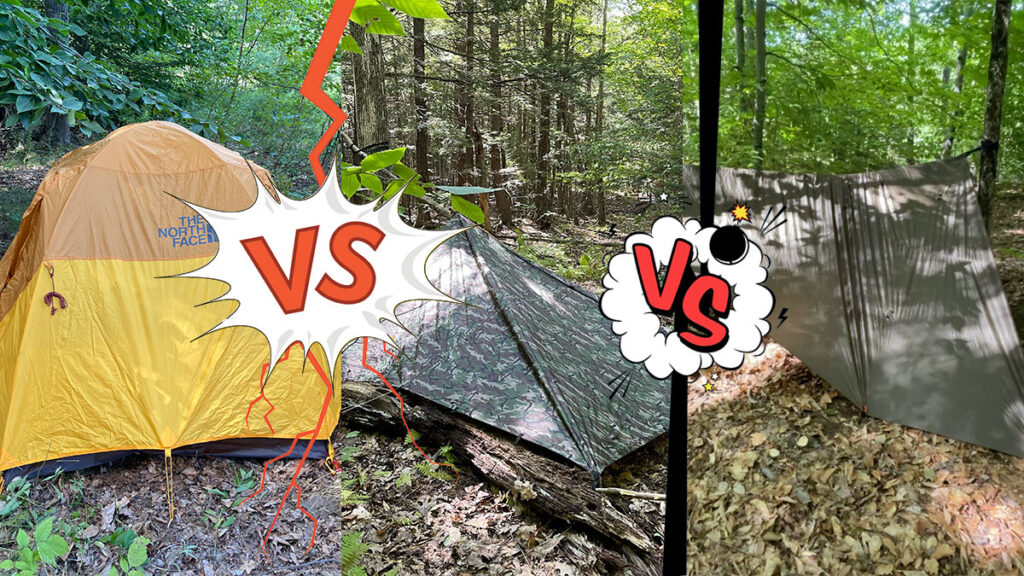
Preppers know that packing a bug out backpack is not easy. You have to choose items carefully, considering the weight and size of each. This is particularly true of bug out shelters. This articles covers the top 3 shelters people consider for a backpack.
Picture this. The collapse has hit. The bombs have dropped. The end is near. You need to escape your apartment, your suburban home, or your Malibu mansion. You need to get from point A – danger – to point B – safety. Your parents’ house in Montana, your cabin in the woods, your bug out location – wherever that is.
But this is a multi-day trip, or longer, and the roads are congested, impassable, or just plain dangerous. So, you’re bugging out with your bug out bag on your back. Your bug out backpack.
But where are you going to sleep on this journey? In the woods? Under an overpass? Anywhere you can? What if the weather is foul? What does your shelter look like?
The way I see it, if you’re working only with a bug out backpack, then you have basically 3 shelter options: a tent, a hammock, or a tarp. But which of those should you choose?
Would you rather watch my video than read this article? I cover it all in this YouTube video:
Witness me!
Tent
The tent I use for backpacking is the Stormbreak 2-person tent from North Face. It’s easy to pitch, and it weighs about 5 pounds. Stuffed for packing it’s 7”x22” in size. It’s available on Moosejaw or on Amazon.
My biggest problem with this tent for bug-out purposes is its bright yellow color. Great if you’re camping on a mountainside, not-so-great if you’re trying to be stealthy.
Of course, not all tents are bright yellow. The Snugpack Scorpion 2 tent that we reviewed is a more discreet forest green. I bought the Stormbreak for hiking use, however. It’s available in a more discreet gray if I wanted it for bugging out.
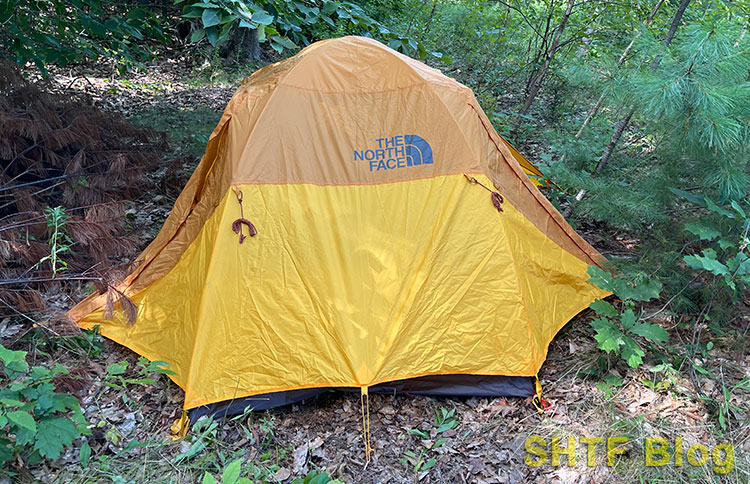 Stormbreak 2 North Face tent with rain fly.
Stormbreak 2 North Face tent with rain fly.
Tent Advantages
A tent as a bug out shelter is probably going to be the choice most people make, and for good reason. The advantages are clear:
- They keep the bugs out.
- They offer a homey feeling.
- You can sleep multiple people in one.
- You can bring your gear under cover with you.
- Most modern backpacking tents are freestanding, allowing you to set them up virtually anywhere without the need for stakes or ropes.
Perhaps the best advantage of all is the sheer number of tents that are available on the market. Want to pack a three-person tent? You can. Need a four-season tent? They make ‘em. They make tents to fit just about every situation and every budget.
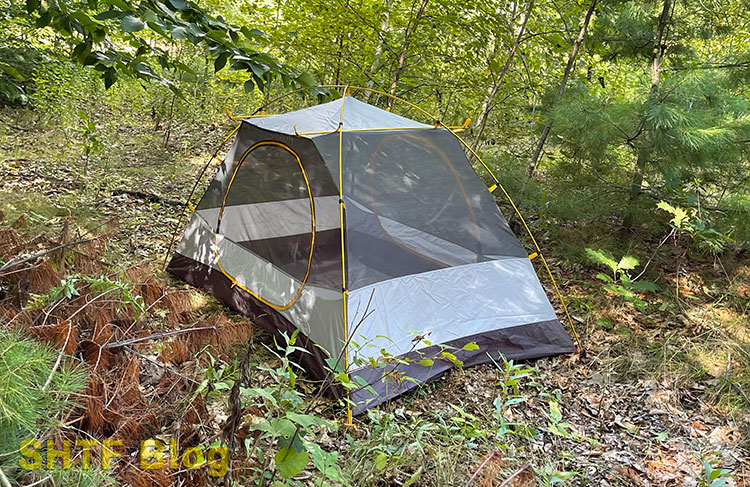 North Face Stormbreak 2 tent without fly.
North Face Stormbreak 2 tent without fly.
Tent Disadvantages
- They can be heavy.
- They can be bulky.
- For a comfortable night’s sleep, you also need to pack a sleeping pad.
Hammock
The hammock I use is the higher-end Onewind 11’ camping hammock with 12’ tarp. This is an all-in-one hammock system that offers a mosquito net and rain tarp combo. It has neat little features like a lantern hanger and overhead pocket.
The reality for my hammock is that it gets far more use around state park campsites than it does in the woods, but that’s a good thing! I prefer to buy prepper supplies that don’t just have to sit around on a shelf waiting for the collapse. Gear costs money, and I want to make use of it now, not just if/when.
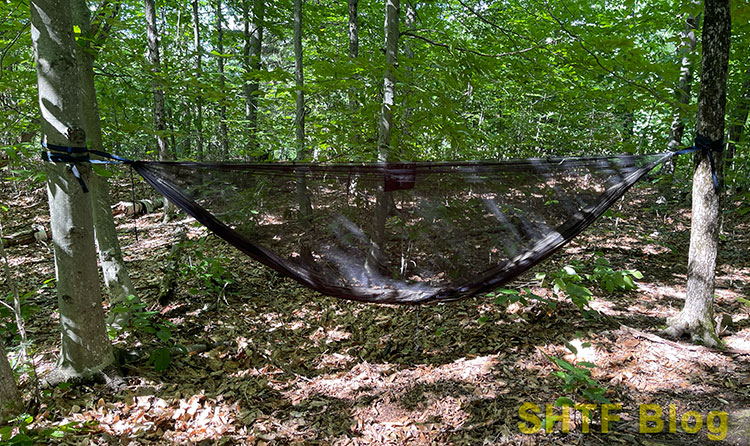 The Onewind hammock with bug screen.
The Onewind hammock with bug screen.
I’d always been suspect of sleeping in a hammock. It can’t actually be comfortable, can it? It can. Surprisingly comfortable. The trick is to sleep in it diagonally. This levels out the hammock. You can toss and turn in it, put insulating padding underneath and on top of you, etc.
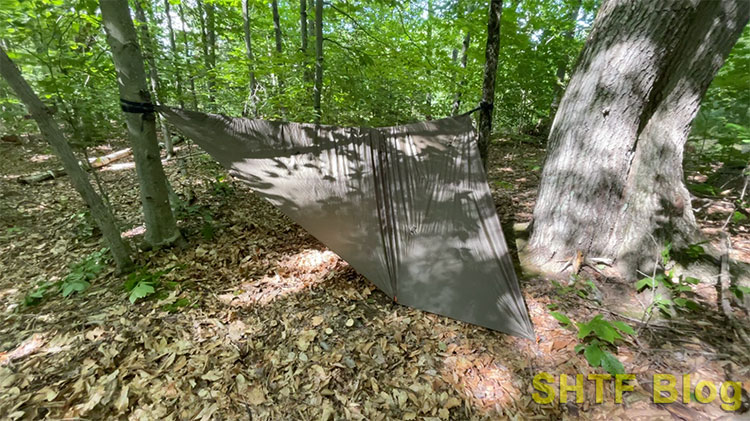 The same Onewind hammock above covered with the tarp fly.
The same Onewind hammock above covered with the tarp fly.
The hammock is also a great solution depending on the landscape you’re moving through.
Hammock Advantages
- You don’t need pack a sleeping pad.
- They pack small and light.
- They get you off the ground.
- Easy to use in uneven terrain.
- They’re comfortable.
- They’re fun.
Hammock Disadvantages
- You are dependent on trees or some type of attachment points to set it up. Setup is not as easy as a freestanding tent.
- You can’t bring your gear in with you (though you can tuck it under the optional tarp cover).
- You need a higher-end model with a bug screen if you want to keep biting insects out.
- Generally speaking, most packable hammocks are made for one person only.
Is it Better to Have a Tent or a Hammock?
A tent is going to be better choice for most situations. They come in different colors, shapes, sizes, and prices. Freestanding tents are fast and easy to set up. A hammock could be a solid backpack shelter choice for the single person who knows he/she will be camping in the forest.
Tarp
Like my hammock, I would opt for a high-end tarp if using it as a shelter. I use a Defender tarp from AquaQuest. And really, if your intent is to use a tarp as a bug out bag shelter, you should look at purpose-built tarps. These tarps are more expensive, but the tarps sold at Wal-Mart are cheap and lack the necessary attachment points that you’ll get with a higher-end tarp.
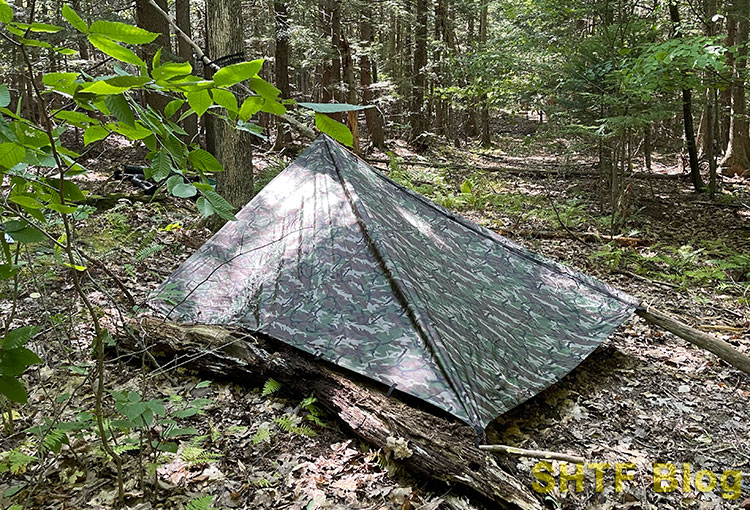 Camouflage AquaQuest survival tarp assembled in the woods.
Camouflage AquaQuest survival tarp assembled in the woods.  Aqua Quest Defender Tarp – 100% Waterproof Heavy Duty Nylon Bushcraft Survival Shelter – 10×10 ft Boulder Camo
Aqua Quest Defender Tarp – 100% Waterproof Heavy Duty Nylon Bushcraft Survival Shelter – 10×10 ft Boulder Camo
- 100% WATERPROOF – The Aqua Quest Defender tarp will keep you completely dry, even in extreme weather. With a hydrostatic resistance of 20,000 mm, you can be absolutely certain that not a single drop of water will get through your tarp.
- EXTREMELY DURABLE – The Defender has a proven record of being incredibly durable and resilient to the forces of nature, even after extended use. 70D nylon + Heavy TPU coating + Reinforced stitching + Heat taped seams = 2.4 – 9.15 lbs of superb defense against mother nature.
I think a lot of preppers buy/pack a tarp as an emergency shelter without ever actually sleeping under one. I get the allure of doing that, tarps are inexpensive, readily available, and you can just toss it in your pack/car with some Paracord and call it good. It takes some practice actually setting one up, however.
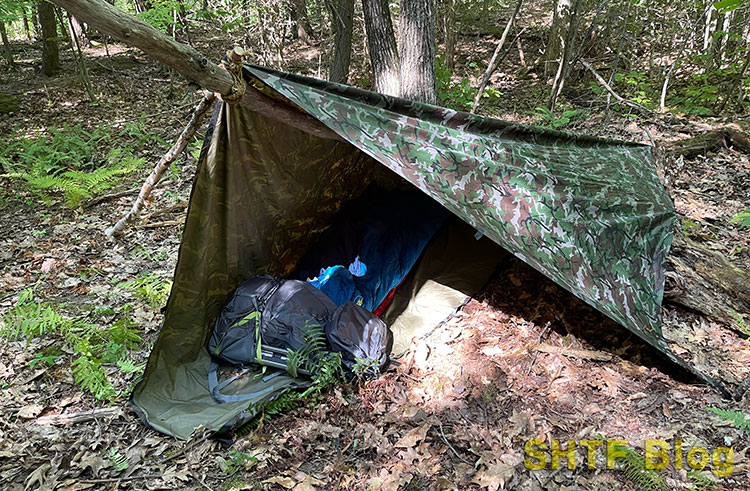 Inside the pitched AquaQuest tarp.
Inside the pitched AquaQuest tarp.
You have be a bit more… outdoor savvy and adventurous to use a tarp as a shelter, almost entering bushcraft land, but they do offer some advantages that you can’t find in a tent.
Tarp Advantages
- They pack very small.
- They are lightweight.
- They have many uses. You can use them to create a blind. They can be used to carry items (or injured people). They can be used for rainwater catchment systems.
- A tarp can cover both you and your gear.
- While a tarp might be seen as more limiting because it’s just a basic square or rectangular sheet of material, in experienced hands, a tarp can be configured into many different types of shelters giving you options.
Tarp Disadvantages
- Setting them up as a shelter is tricky. It takes practice to learn different methods. It’s helpful to know different knots, and to carry plenty of Paracord.
- They do not get you off the ground – at all.
- They do not keep biting insects out – at all.
Is a Tarp Better than a Tent?
A tent is a better shelter than a tarp, but a tarp is a more versatile piece of equipment. You can use it for many different purposes, it’s less expensive, and it packs tighter and lighter. A tarp could be the perfect “just in case” shelter for your bug out vehicle, however. It would not be as good as actually sleeping inside your BOV, but if you had to leave your vehicle behind, the tarp would work well.
Can a Tarp Be Used as a Hammock?
You could technically suspend between two trees as a hammock, but it’s not going to work well for that purpose. It will be noisy and uncomfortable. It’s not shaped or designed as a hammock is.
What About No Shelter at All?
Some might scoff at this idea, but for the person who is focused more on being lightweight and speedy in a bug out situation, skipping a shelter altogether might be a suitable option. I would only recommend this in limited cases, however – mainly young, fit people who also have means of staying dry in rain (think poncho).
Depending on your planned bug out routes, you may be able to find discreet shelter/sleep areas along the way. Some people experienced in bushcraft can also make hidden shelters out of their surroundings. This is not most people, however. The average prepper will be better suited to having a tarp at least.
Bug Out Shelters Summarized
If you’re struggling over which one to get, the answer is easy. Get them all! Pack the tent for all-purpose… purposes. The hammock, you could use that not just as a pack shelter, but also right around the house for everyday use, reading post-apocalyptic fiction.
The tarp, that’s a perfect choice for a vehicle kit. Odds are high you might need a tarp for something vehicle related, covering something, or needing it on the ground. Then, if you break down in no man’s land and need to hike out – bam, survival shelter.

